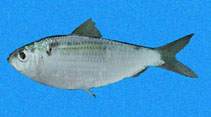| Family: |
Dorosomatidae (Gizzard shads and sardinellas) |
| Max. size: |
18.4 cm TL (male/unsexed) |
| Environment: |
pelagic-neritic; brackish; marine; depth range 0 - 50 m |
| Distribution: |
Eastern Pacific: La Jolla, California to Peru (at least to Callao), including the Gulf of California (Ref. 35601). (This species seems to have two forms or subspecies: Harengula thrissina thrissina from the Gulf of California to Panama and Harengula thrissina peruana from Panama to Peru). |
| Diagnosis: |
Dorsal spines (total): 0-0; Dorsal soft rays (total): 13-21; Anal spines: 0-0; Anal soft rays: 15-17. tooth plate on tongue and tooth plate behind it (basihyal and basibranchial tooth plates) broad, their width about 3 to 5 times in their combined lengths. Last dorsal fin ray not elongate (cf. Opisthonema). |
| Biology: |
A schooling species found in coastal waters. Form dense schools along shores and estuarine areas with salinities slightly lower than that of saltwater (Ref. 9291). Feed on planktonic crustaceans (Ref. 9291). Oviparous, with planktonic eggs and larvae (Ref. 35601). Utilized as bait (at least in Mexico and Costa Rica) (Ref. 9291). |
| IUCN Red List Status: |
Least Concern (LC); Date assessed: 01 May 2008 Ref. (130435)
|
| Threat to humans: |
harmless |
Source and more info: www.fishbase.org. For personal, classroom, and other internal use only. Not for publication.
